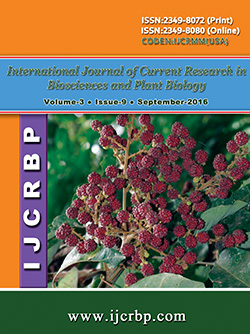 |
Online ISSN : 2349-8080 Issues : 12 per year Publisher : Excellent Publishers Email : editorinchiefijcrbp@gmail.com |
2Department of Vegetable Science and Floriculture, CSK Himachal Pradesh Agricultural University, Palampur, 176 062, India
An experiment was conducted for two consecutive years at two different locations to identify the best genotypes based on per se performance in chilli for yield and component traits along with horticultural and quality traits. The thirty three F1s, fourteen parents and standard check ‘CH-1’ were grown in a Completely Randomized Block Design with three replications at Palampur and Bajaura for two consecutive summer-rainy seasons during 2010 and 2011. Existence of sufficient genetic variability among treatments was evident from the analysis of variance for all the characters in pooled over environments. A wide variation was observed in the mean performance of 14 parents and their 33 crosses derived from these parents for different traits pooled over environments. Cross ‘LCA 436 × Pant C 1’ recorded the highest marketable fruit yield (615.23 g) and dry fruit yield (70.59 g) which was 68.37 per cent and 47.27 per cent higher over the standard check ‘CH-1’, respectively in pooled over environments. This cross also produced maximum fresh and dry yield /plant in the respective environments over the years.
